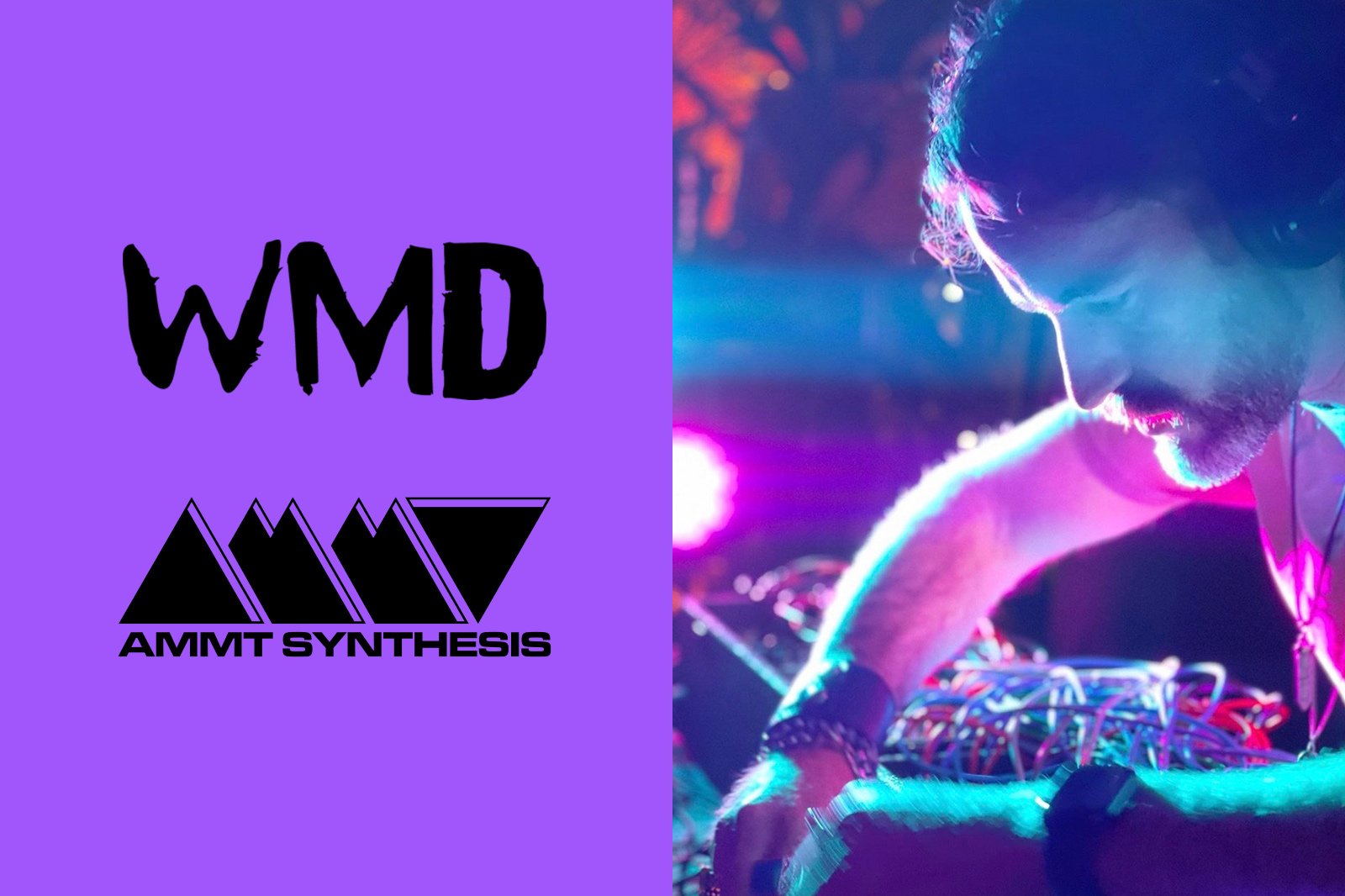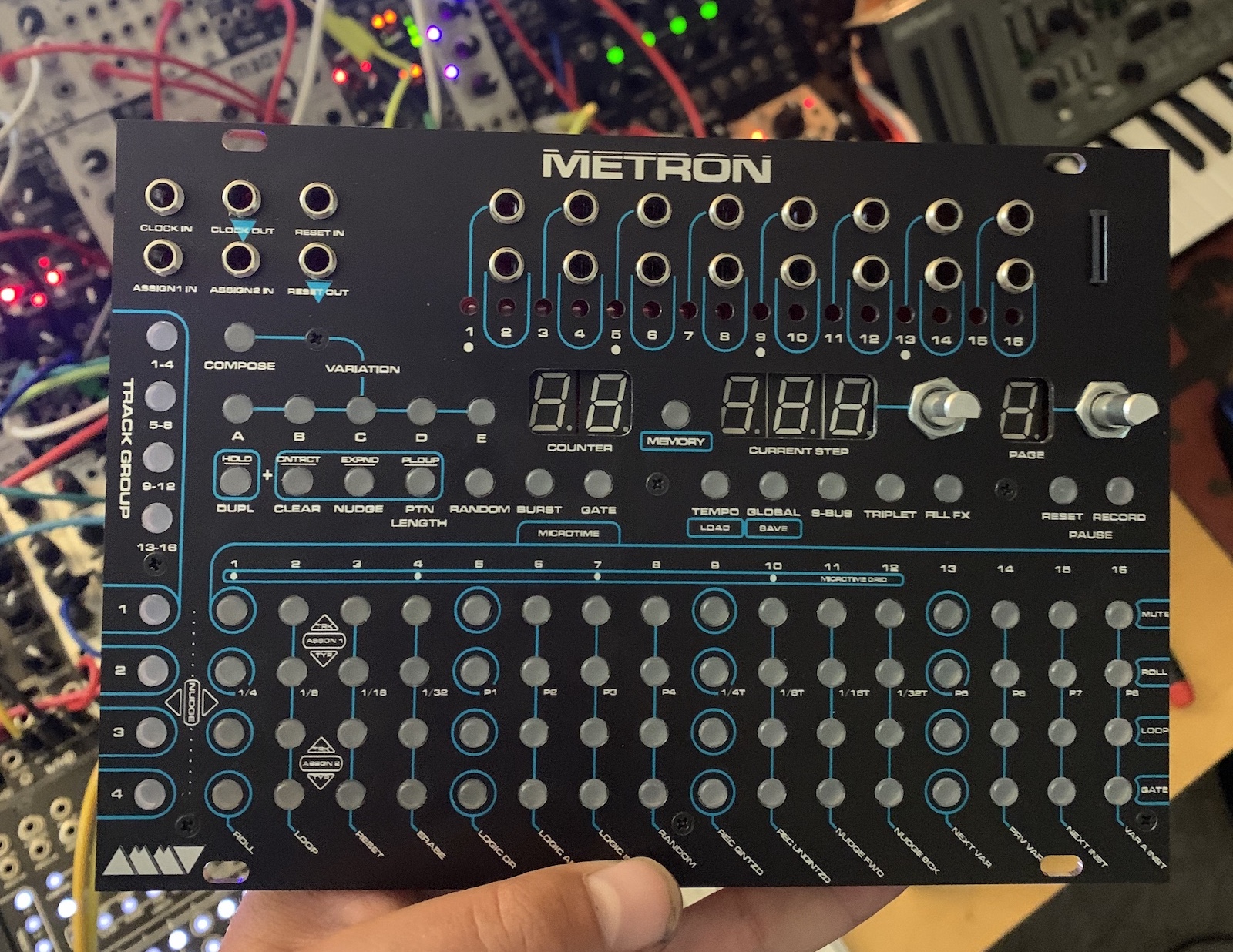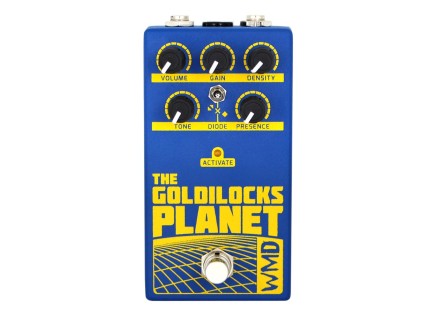If you've been in the Eurorack modular synth scene for a little while, then you probably know a couple of things about William Mathewson Devices (better known under its acronym, WMD). First thing? They've made some of the most interesting Eurorack modules of the last ten years, including gamechanging performance-oriented designs like the Performance Mixer and Metron, and much more.
Of course, you probably also know that WMD announced that it was closing its doors in late 2022. This news came as a shock to many Eurorack-centric performers. We'd seen some smaller companies fold due to supply chain complications in the post-COVID manufacturing landscape...but seeing a company as established as WMD close down forced a sobering realization—a realization that the companies and tools that we love aren't a given. After the announcement of the company's closure, WMD received an immense amount of support from the modular community, with many publicly paying their respects and wishing them the best going forward. In a strange kind of way, it brought many in the community together: public discussion about WMD's closure brought out a sense of gratitute and reverence that otherwise is often buried in the hustle and bustle of electronic musical instrument creation/commerce. Many openly hoped for a day when WMD would be able to re-emerge...and for all of those folks, today is your lucky day.
We've got several layers of good news: 1) WMD is resuming operation; 2) There are plenty of new and old products in the works; and 3) Many WMD designs have branched off for production under a new company called AMMT Synthesis, headed by Mathewson and several of his colleagues from WMD (Alex Anderson, Matt Tanner, and Mason Malvinni). I'll start by saying that we don't expect to see new products in the wild from WMD or AMMT until sometime later this summer at the earliest; but we're beyond thrilled to hear that some of our favorites (Performance Mixer, Metron, and more) are going to be available once again, in a slightly updated form.
With that high-level overview behind us, let's get deeper into the weeds. We interviewed William Mathewson himself to better understand WMD's history, the reasons for their closure, the reasons for their return, and the ideas behind the new version of WMD and the new company AMMT. If you want a deep look at the history of one of the most influential Eurorack synthesizer manufacturers, or a glimpse into their future—read on.
WMD History: Formation + Evolution
Perfect Circuit: Hey William! Thanks for taking the time to talk; we're super glad to hear from you. I suppose we have a lot to talk about—but before we get into the news, I think it might be best to discuss how we got here. Most of our readers are familiar with your past work as owner & lead product designer for WMD; and of course, many of us were saddened to hear last year's announcement that WMD was closing its doors. Can you tell us a bit about the history of the company? How did WMD start? How did it evolve over time?
William Mathewson: Hey fellas, great to talk with you! So yeah, some background about the beginning of things…I first learned about modular synthesizers from my AES professor (Roy Pritts RIP) back when I was in school for audio engineering, he had an old Moog modular, and the school had an ARP 2600 that mostly worked. This was back in 2005. I had been tinkering on tube amps and building clones of pedals for a few years, having always been into building kits and electronics and using them for my own music making. I was getting into making pedals for some bands that would record in the studio I assisted at (Far & Away Studios in Boulder, CO) too which was super fun and validating. They were just clones, but I’d do little mods and really learned a lot by tinkering and trying to get them to sound like what the band wanted.
At the same time, I had this other day job at a small weird engineering firm in Boulder too, where I was paid to engineer little custom cutting and pulling machines. The company made stepper motors, and sold some conversion kits for cheap milling machines to make them CNC. So I learned a ton about manufacturing and running a business, and also some level of how not to do things. We would do everything in house, including hand soldering of 0402 boards (boss was too cheap to use a contract manufacturer). My boss once designed this tiny motor controller that had an enclosure so small that we had to dremel a corner off of a mosfet to make it fit inside, awful design stuff, and for production. The products were really pretty cool though, super tiny compared to industrial stuff at the time. So it was pretty high-tech, but done in such a DIY way that it wasn’t a sustainable business. But my boss was super cool and let me use the shop to machine the first few runs of enclosures for WMD stuff, the Fatman and later the Geiger Counter pedals. I did this weird job during the day, at night I’d work in my garage teaching myself AVR assembly to code the Geiger Counter. I took some Assembly in College on the Motorola 68k, so I was familiar with microcontrollers at that low level, but AVR is so much nicer to work with. I never learned how to code in C on embedded hardware, so any of the WMD projects that I coded were done in assembly.
From there, the Geiger Counter was a surprise hit, and there was a ton of demand for it. I got requests from a few LA dealers to make it into a eurorack module. Eurorack was new to me, this was like 2008/9, when there were maybe 10 other companies making Euro modules. I was having a hard enough time keeping up with pedal demand, but Shawn from AH pre-paid for the first 100 Eurorack Geiger Counters, before I even started engineering, so I had the money and motivation to develop on Eurorack. I think we had two employees at this point, so I was able to shift focus and really get into modular without production falling apart.
From there, we put out a few more pedals, but they never really took off like the Geiger did, and I was starting to get more into modular. There was so much more creative landscape to explore on the synthesizer side of the business, and it was a ton more fun. And if I put out a 100 piece run, they’d all sell pretty quick, and I was able to make a decent living while paying a few people well. We were just working out of my detached 1938 brick garage in Denver, overhead was nothing back then.
For a few years it stayed about the same, from like 2011 to 2013. I put out the Synchrodyne and Phase Displacement Oscillator, the Sequential Switch Matrix, some expanders and utilities. I didn’t really have a cohesive plan in place for modular, I just had ideas about what I thought would be cool, or was an interesting technology to explore the sound of. The creative process was slow, but the shop was at my house, so I could work like 80 hours a week on design and production, and still have time to play some Starcraft II or Call of Duty.
In this time period, I upgraded the garage power, and invested in a tiny pick and place production system. It was a bad ass little bench top thing, with flying cameras and really satisfying air piston driven feeders. The whole system was around $45k at the time, which was a huge investment for me, so I started to ask around if anyone needed SMT help. The Eurorack industry was a tight community then, everyone was small, so there was a ton of camaraderie and information sharing. I was able to help a few other manufacturers run their boards, or build and test full modules, and our contract manufacturing (CM) wing was born.
SSF was my first client—Andrew Morelli is a great designer, and we started to collaborate on ideas too. We co-designed an entire line of mid-priced basic modular building blocks with a really solid feature set. Ten modules to start, and I think 14 in total. This was a huge undertaking, but it did really well and helped a lot of people get started in Eurorack, as the modules were super accessible. Around this time too, Alex Anderson moved from doing assembly work to handling marketing, making videos, and eventually taking over WMD’s sales. Alex did a bunch of really great videos that helped get people interested in modular synthesis, based around showing off the WMD/SSF collaborative line.
In 2013, we started on a new major CM gig, working with Mark Verbos. His modules were insane, tons of parts, really beautifully designed and engineered. We helped launch his first five modules, doing prototyping, panels, and finally production. We realized this was way too big for us to easily handle in my garage, so we decided to make a move to a larger facility in the spring of 2014. We got a 1500 square foot office/warehouse in a storage-unit park. We moved everything over in a day and were up and running again 72 hours later. Things were really efficient back then, I could keep track of most things in my head. There was no inventory control or real systems in place then. We just did stuff as it was needed. At this point, we had like 10 employees though, so things started to fall through the cracks, projects would be forgotten for a while until a client sent me an email. So we started to build some basic systems, work orders, project tracking. I was still working really long days trying to keep all the parts working together. Juggling eight or nine contract clients, helping many of them with schematic and design services, and doing a lot of the quality control and testing myself. From about mid 2013 to sometime in 2016, WMD didn’t put out any of its own products. I was too busy working on client stuff, and the WMD/SSF collab that any of my own aspirational designs got shelved for quite a while.
Eventually we realized that the small benchtop PNP machine wasn’t going to cut it, and there were other issues with the little facility we had. It was carpeted, which was terrible for static control and we were still using the Kobiconn minijacks, which had little loops which we’d have to trim off of each jack before insertion, so there were thousands of these little bits of metal in the carpet. We moved in 2015 to a 3600 SF facility, properly industrial with 3 Phase power, and I ordered a Samsung pick and place machine, about $105k. This thing let us make way more boards, and the placement accuracy was much higher. We eventually upgraded the other pieces around the machine, and built a really solid SMT production line over the years. Fully conveyorized and automated by 2017.
We added yet more clients once we had this big ass machine, I had more bills to pay, so we needed more growth. Noise Engineering was blowing up then and we did a ton of R&D and production for them. I think at the peak we were doing prototypes of three different modules a week for them, they had an incredibly ambitious release schedule. We still didn’t have a solid inventory management system in place though, figuring out how to integrate the old accounting software with something is a huge and costly problem to solve, especially when you have to keep doing production. We finally integrated Aligni to our workflow which helped keep track of parts and revisions of products, but it took so long to get done that we’d ended up pissing off some clients with our disorganization, and they moved to another CM.
Anyway, back to the history, I had a child in 2016, and that forced me to pull back from WMD a lot. I had to learn to delegate things, but we didn’t have the systems in place for that to work so smoothly, so I was constantly needed. If I were going to start something new, I’d definitely put the systems in place ahead of time so that the company is more designed, and scope controlled. But this letting go of things phase was really helpful and made me more trusting in people’s abilities. I had to relax my control-freak tendencies at least a bit. That led to giving people much more power in the company, and having a middle management tier taking care of things.
This led to also having to deal with firing someone high up in the company that I’d groomed for years, who was very productive, but was an absolute asshole to employees, and eventually, to clients. I’d never had to deal with that kind of stress before; he was very effective, but not a good cultural fit. So firing him was a really scary thing, because there was so much tribal knowledge he had that I thought I couldn’t live without. I put it off for months, I even dealt with it in therapy and finally came around to what had to be done. I’ve gotten better at making those tough decisions but it still riddles me with anxiety.
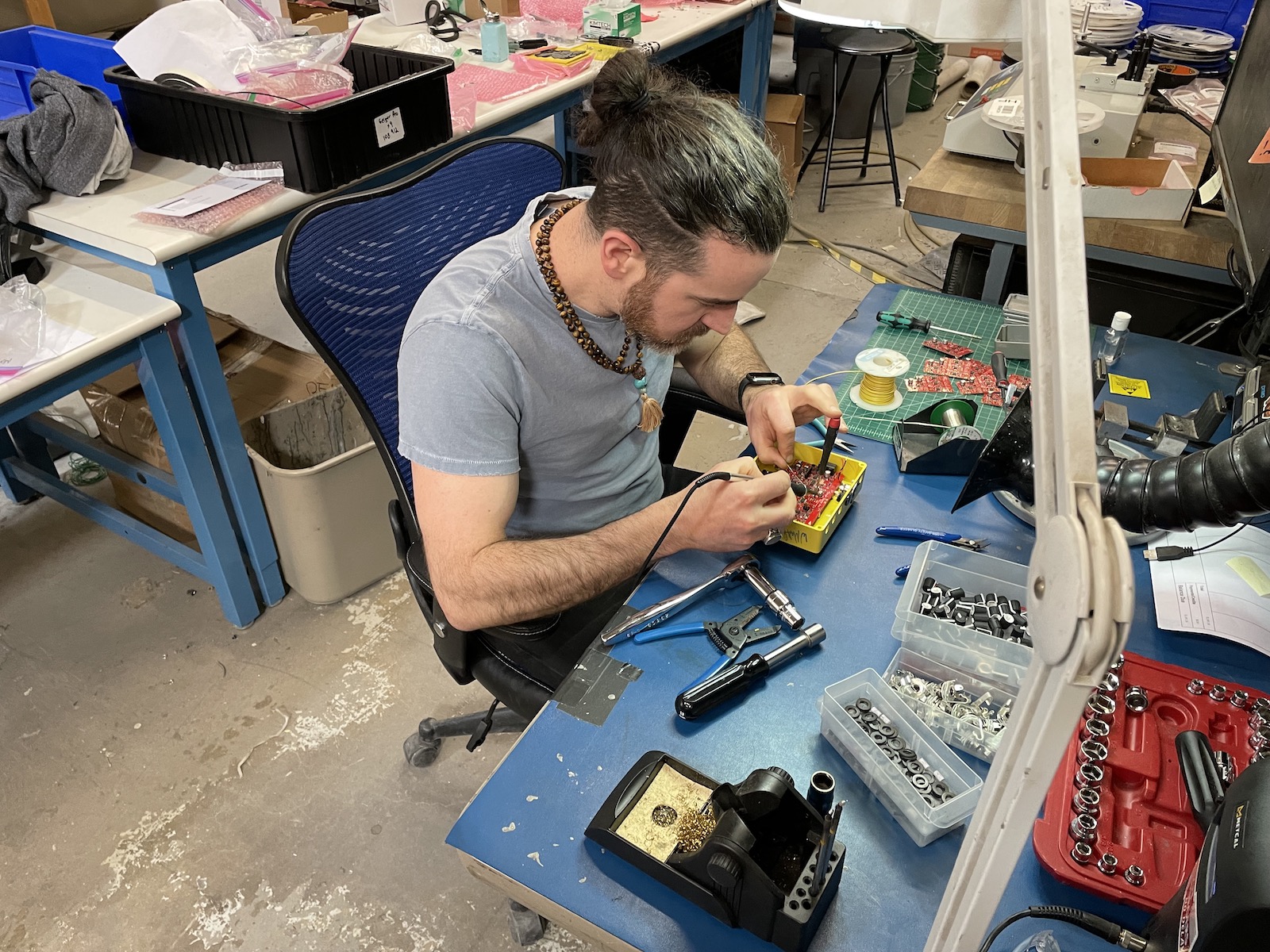
[Above: William Mathewson at work on a Geiger Counter Pro]
Management was something that I had to learn to do, and I still struggle with. I love the engineering and creative side of things, but you can’t run a company on that stuff. Motivating people is really challenging, I have to psych myself up for meetings or group-work. I definitely like to be in the shadows and background, I want my modules to be the focal point, not myself.
Between 2013 and 2018, we were very involved with NAMM as well. WMD got a giant booth and would host a bunch of Eurorack manufacturers. We designed a table/sound-isolation panel system that helped you actually hear the damn speakers in the exhibit hall. All the stuff had to be trucked out, it was like 6 pallets. This was a ton of work, and we had a crew of four for an entire week in California. It was really good for the Eurorack industry and we lobbied to get the booth near Moog and DSI on the tradeshow floor to make Eurorack a bigger deal. I think it helped elevate us all a lot, and we definitely all got some great press and good conversations with our heroes from doing this. I think we peaked at 20 companies all sharing a 50’ x 20’ peninsula booth. Pulling those long days was really fun, and so was getting to see so many colleagues and friends. We quit when NAMM started offering half booths for cheap and a couple companies backed out after we’d already committed to booth space, so we took a major loss on the last one and I decided it wasn’t worth the risk or wear and tear on my body and spirit.
We added a few more machines in 2017 and 2019, a Selective Soldering system which drastically improved quality, as it automated much of the soldering we were doing by hand. And a super amazing milling machine in 2019. This allowed us to make our own panels in house, with this beautiful engraving. They really popped, and allowed us to iterate the artwork on finished panels rather than hoping it would turn out when ordering from a third party. So basically at this point, we were able to do every operation in house, except for making the bare PCBs. We had a brief stint trying to print our own panels and stompbox enclosures, we bought a direct to substrate printer but it was so finicky at Denver’s altitude that I eventually sold it at a big loss.
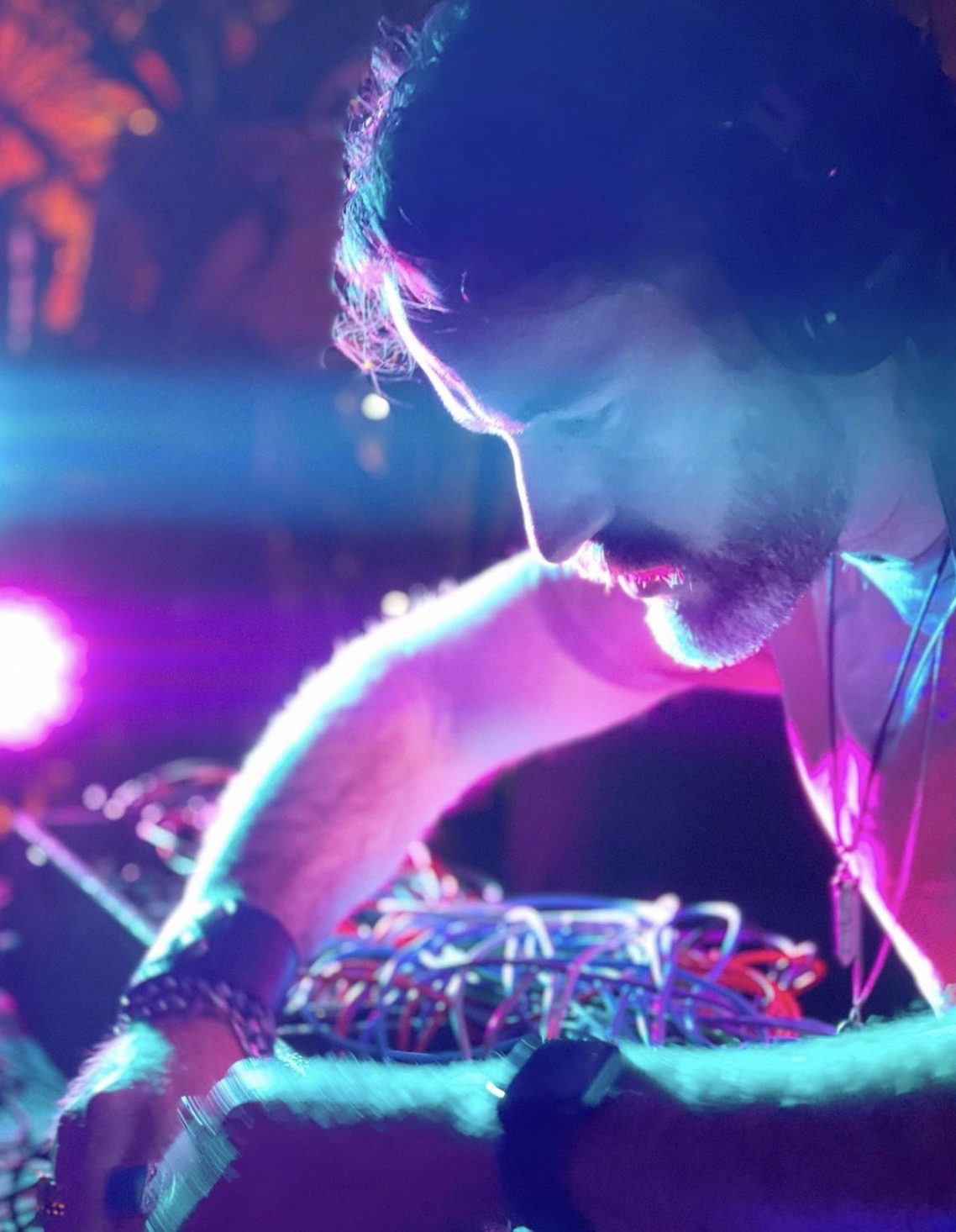 William Mathewson performing live
William Mathewson performing live
Around 2016 we also honed in on WMD’s brand ethos, we began focusing on live performance modules. We’d been going to lots of live modular events, and I thought a lot about how we could improve people’s patching confidence and ability to do more with the modules they already had. And we developed the Performance Mixer over like 18 revisions, which I think launched in 2017, with a quick recall because I’d made the fader law super weird. We fixed it and re launched that module with great success. It’s been one of our best selling pieces, and I’ve heard from countless musicians how much it’s changed the way they patched. It changed how I patch as well.
Shortly after this shift, we started Freq Boutique in March of 2017. Where we have six performers play live for 15-20 minutes followed by a Q&A. Super friendly and supportive to help get people to play live and bring their gear out. We’re still doing it, going into year six now. Being a part of this shaped how our modules were designed further, digging further into the live performance possibilities and Metron birthed from the need for a really powerful trigger sequencer where you could edit stuff that wasn’t yet playing. Metron would take like three years to come out, I think we launched in early 2019. I had a software guy working on it, but nothing was clicking after months, and I knew the hardware was capable. Turns out I had the wrong guy doing the work, and I had to fire him. Serendipitously, we had this great assembly tech who was teaching Arduino classes on the side, and I gave him the Metron hardware to see what he could do. That dude is Mason Malvinni, and he’s responsible for coding Metron and developing the sound engines on Chimera, Fracture, Crucible, and Kraken.
It evolved into a really well oiled machine around the beginning of 2019. We had an amazing crew then, a few really talented engineers handling code (Mason Malvinni), and analog/manufacturing (Stephen Kraig). Testing was drastically improved and we had procedures for everything. The company started to operate pretty seamlessly and without a lot of oversight, this freed me up to do lots of design work. We engineered C4RBN, Javelin, AXYS, OSD, Time Warp, Crater, Kraken, and probably a few others in 2019 going into 2020.
WMD's Closure + Return
PC: The last couple of years have been fairly unstable for many small manufacturers, for a number of reasons. Can you talk about some of the factors that led to the decision to close up shop at WMD?
WM: 2020 was going to be our year man! We were flying, and things were really finally going the way we wanted in just about every way. The team was fire, we were efficient. The products were beautiful and sales were really good. Even into the pandemic. We came up with new ways of working, and we isolated people as best as we could. Testing and hand assembly people moved their stations and tools home, people with machine workcenters and kitting had to stay at the shop, but had enough space to be socially distanced. We put cleaning and masking protocols into place, we stayed operating as an essential business, and did so legitimately safely. I’m really proud that we kept people employed and working through that fucking horror show of a year and a half. We had some turnover and new hiring during this time too and had some great people join the team. Because many of us were remote, myself included, I didn’t meet a couple of my employees until we had a company holiday party in 2021.
Since we were all working remotely, it was hard to address quality issues or little improvements. I had a production manager who was trying to do this job, remotely over Zoom and text, but it’s a real struggle to get things right. Mid 2021, I started to feel really disconnected from the company and we tried to get people to finally come back to work once we had vaccinations to get things going again. But people liked their remote work, and the Omicron scare made us push back plans to have everyone in the office, and it never happened. People were still working remotely up until April of 2023. I kept getting push back from a couple managers about making everyone come back to work.
Also around the beginning of 2022, the semiconductor shortage started to get really fucking real, and I couldn’t get parts, or was getting gouged for parts. WMD was set up to be able to get parts as needed so we could run production, we had some inventory, but we have too many products to plan two years in advance about what gets run. If we made one thing, sure, the parts shortage wouldn’t be much of an issue, but not with 30 products, plus a bunch of clients trying to make shit too. I was spending 30 hours a week trying to find parts, up from four in the pre-pandemic times. This started to wear on me too, and I was spending lots of money on parts inventory that I couldn’t use because some other part was missing. So we started to hemorrhage money.
So by spring 2022, I didn’t know like half the people that worked for me, I didn’t prioritize it, I didn’t see them every day, and was still getting push back trying to get people to come back to the factory, the culture was kind of dead. Running WMD wasn’t fun anymore, and it was $500k in debt from salaries and parts. I still couldn’t get parts to keep up with production. I was done and needed a way out for my own sanity.
So in August of 2022 I let staff know we were done. We had 20 people then, and I told them all that they’d lose their jobs over the next however-long (9 months it turns out). And I told them to get to work finding new jobs, but not to take the first thing they were offered, find something good. A few left fairly quickly, and a few are still hanging on and helping out as we are still trying to make a clean transition.
I let all my clients know we weren’t going to be able to continue manufacturing as well, and we ran some final runs for several of them as parts were sourced. Hexinverter came to similar conclusions around the same time, we had a really validating conversation about the state of things. Letting go of Contract Manufacturing was hard, as I let a lot of people down, but really freeing in that I don’t have to carry the stress and burden of it any more.
PC: Of course, we're talking to you today because, in some ways, things are turning around: you're now involved in not one, but two companies: WMD and AMMT. First, I want to talk about WMD—it's amazing you're coming back! That said, we understand there are probably some changes in the structure of the business. What made you decide to keep going with WMD?
WM: Originally I was totally done with the thing, I wanted all the way out, but had no idea what I’d actually go do. I made the public announcement and then left for my first Burning Man a couple weeks later, hoping that some new opportunity would strike me there. Honestly, I didn't know what to expect being in the desert for 10 days, and I didn’t find any direct connections for the next new big venture or anything grand like that. What I found, through a shitload of hot hard work, was that I wanted to be more collaborative, and not be the lone wolf at the top of an organization. I wanted colleagues, not employees…I wanted to work with people, not have people work for me. Being out there and seeing the massive projects being built by volunteers and people who just wanted to make beauty was really inspiring.
As for how that made me want to keep WMD going, I saw what WMD did for the community in a larger sense, how we’ve helped people make art, and I didn’t want to let go of that. I wanted to continue to create, but in a mentally healthy and sustainable way.
[Above: Photos from WMD's regular Freq Boutique shows above, courtesy of David Soto of Colorado Modular Synth Society]
PC: When you announced that WMD was closing—well, everyone seemed pretty taken aback. We know that you're personally a big part of the local electronic music scene in Denver, and the modular community in general has really embraced your work as a designer. Do you feel like the community's response impacted your decision to keep WMD going? What role does community play in the direction of the company?
WM: Community has been huge for us, we helped to build the Denver scene which is thriving right now, we see new faces and performers at Freq Boutique all the time, so it’s still growing. And the larger modular community came out in force when we announced, I got a lot of feedback through many channels, and I felt really valued for my contribution to the industry. Before the announcement, I felt really disconnected from it all. Airing our situation to the world was a massive weight of my shoulders and getting this feedback re-grounded me to the mission of building awesome stuff. I just knew I couldn’t be the one responsible for the building part any longer.
WMD + AMMT: The Future
PC: Tell us more about this new chapter for WMD: what about the business is changing? What about the business isn't changing?
WM: We’re no longer manufacturing in Denver, or doing contract manufacturing for anyone else. I’m moving out of our 7200 SF warehouse in June to a much smaller R&D only space. We’re no longer handling fulfillment of our products. Basically WMD is scaling all the way down to a research and development company, where I can design modules, and have them manufactured in California, and I’ll make royalties. Funny enough, it’s the same arrangement that WMD did for so many clients, I just get to be on the client side now.
As far as what’s not changing, we’re keeping quite a few modules in production, but we will be doing limited runs of others. The performance modules will be produced in multiple runs, and will be stocked normally. But utility style modules may just see one large run and be done. We can’t afford to tie up so much money in inventory that sits on the shelf for a long time.
Continuing any pedals is still up in the air, I’m leaning against for the time being.
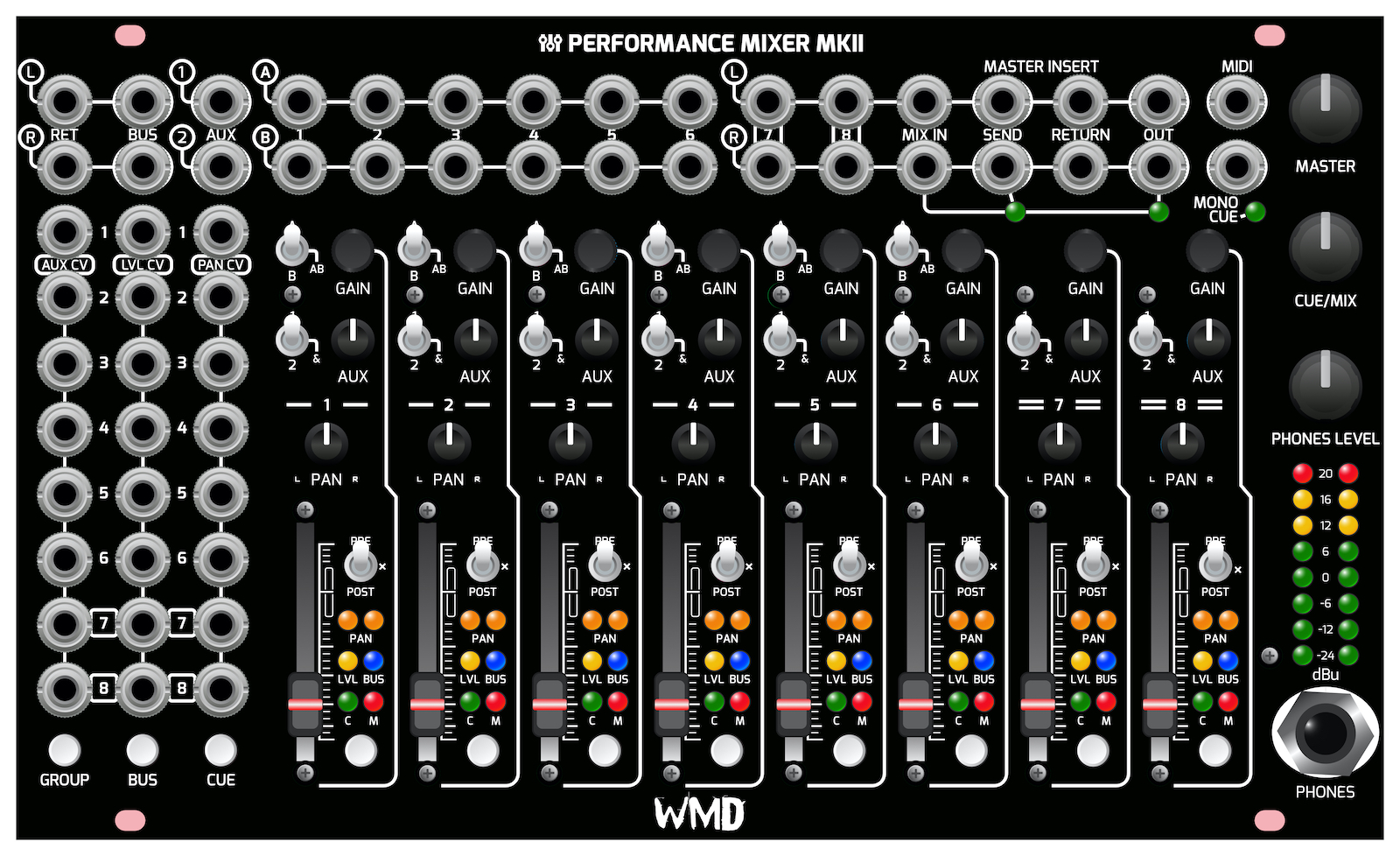
PC: Can we expect some of our favorite WMD products to return to production? We know that there are an awful lot of people out there who are sad they missed out on the opportunity to get a Performance Mixer, for instance.
WM: Yes, the Performance Mixer will return—we have a new MKII version showing at Superbooth that has some community requested features, MIDI out, and a far superior manufacturing process that lets us replace the damn faders in the field if they get too much crap in them.
Of our core line of voice modules, C4RBN, Javelin, Legion, etc., we’re going to continue to make them. Legion uses so many advanced parts that it’ll probably be years before it comes back into stock though.
PC: Are there, perhaps, any new WMD products in the works that you can talk about?
WM: I’ve got a new MKIII version of the Digital VCA that we’re showing at Superbooth too. I’ve always loved that module, it’s so fun and quirky and useful for bass sounds. It’s a really powerful utility.
Scorpion is the wavefolder I’ve been tinkering with since the beginning of the pandemic, I’m hoping once things settle down that I’ll have some serious woodshed time with it to get that one done finally.
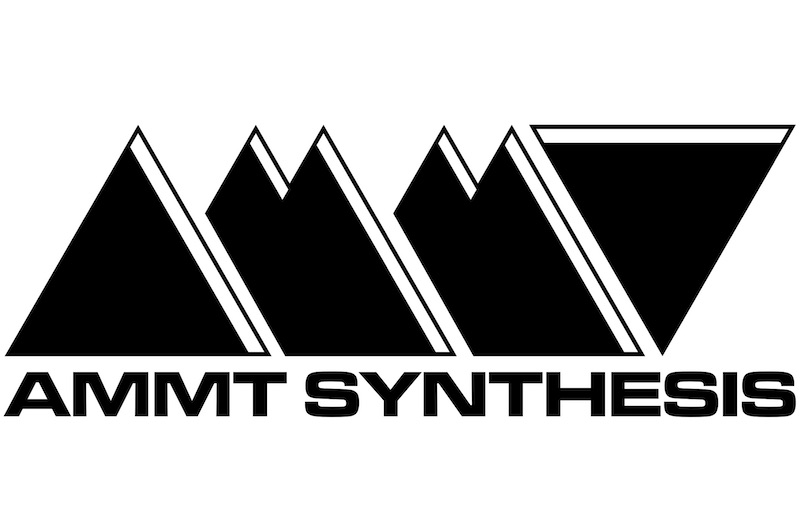
PC: Okay, but WMD aside—there's a whole other company to talk about here, as well. What's the story with AMMT? What's the idea behind it, and why/how is it separate from WMD?
WM: So, there’s three people who really helped make WMD into what it was at the peak design wise: Alex Anderson, Mason Malvinni, and Matt Tanner. And I love working with these guys, so I thought maybe we should form a company together, where they can actually own the shit they help design and benefit long term from their efforts.
So AMMT is owned by all four of us, and nobody gets paid unless we sell stuff, so it’s really simple vs having all the employee and office overhead. The team is small enough that we can keep each other in check and motivated. We get breakfast every week at a little diner and it feels like the old design meetings pre-pandemic, which were so much fun to take part in, and bore so much amazing fruit.
PC: So, we gather AMMT, then, is going to take over production for some familiar designs originally released by WMD. What is the starting lineup for AMMT going to look like?
WM: So AMMT is taking on the Metron suite of products, and all the digital/hybrid drums. Aesthetics will change, toward a more classic '80s synth look. So we’ll have firmware updates for Metron in the future, and they’ll be compatible with the WMD versions of Metron and Voltera.
We’ll be working on AMMT MKII versions of the sample-based drum modules in the future. Kraken and Crucible are purely DSP models of a snare and cymbal, and those modules will continue as-is under the AMMT name.
PC: Are there any new AMMT products in the works you can tell us about?
WM: Yes! We’re showing a prototype hi-hat module at Superbooth. The hardware is similar to the other digital drums, but we have a second layer of knobs for additional settings. The hi-hat is sample-based, but really dynamic and powerful. It’s still in early stages of development but we plan on shipping this year.
PC: So, between WMD and AMMT—you're clearly planning on keeping some of the old designs alive. How do you decide which of the older designs make most sense to continue producing? For designs that didn't make the cut—do you think you'll revisit those concepts/ideas/sounds again down the line?
WM: For WMD, a lot of things are getting cut because we don’t want to have inventory on the shelves that doesn’t move quickly, it’s not good for business. The modules we’re keeping are the hotter selling ones, or the ones that really define WMD. Only a few are going to remain unchanged. One major criteria is manufacturability, so most old designs that require hand soldering are cut because of that alone.
I’ll likely revisit some of the older concepts like the Synchrdoyne, PDO, and Switch Matrix, but with all the UX knowledge I’ve gained over the years. They’ll need lots of modernization and cleaning up.
[Above: Alex Anderson, Matt Tanner, and Mason Malvinni performing live at Patched Out! in Denver; images courtesy of MANMADEMADMAN]
PC: We know that many of you folks at WMD and AMMT are active performers. Have your lives as performers impacted the way that you think of instrument design? Conversely, have any of your designs affected the way that you think about performing?
WM: So for a long while now, we’ve been performing live, that's where the concept for the Performance Mixer was born. We’ve also put out DJ style tools like AXYS and Overseer, which were born from the need to transition in a live setting.
I’ve started DJing a fair bit on CDJs, and I’m inspired to make more DJ-style tools available in the modular world. It just helps so much with moving from idea to idea and keeping your modular live set fresh. The tools that we’d need to design are more difficult than the ones we’ve put out so far though, requiring tempo sync, or even interfacing with the Pioneer gear directly.
Subway and Legion affected how I did my most recent set quite a lot. Subway let me do a bunch of different timbral stuff quite easily from the oscillators, especially when driven by an envelope. And Legion made it so I didn’t have to tune during sound check or worry about tuning at all.
Metron and Voltera are really the core of what I do in a live setting. I’m more of a writer, where I set up lots of sessions/songs in Metron and then transition through things and play the timbres and bring instruments in and out as I go. Kind of like a DJ would approach a set but with stems and full timbral control. I try to write with an arc in mind.
PC: I think I can speak for more or less everyone when I say that we're excited to have you back—the absence of WMD from the Eurorack world (albeit brief) was a shock, and we're really excited to have you folks up and running again…and with some exciting new ideas and directions! I guess the big questions that are likely on everyone's mind…when do you think we'll start seeing new WMD and AMMT gear in the wild?
WM: Yeah we’re glad to be back in this evolved form, it’s been a hell of a year figuring out all these plans, but it’s really coming together and I couldn’t be happier.
Javelin is the first product moving through our new supply chain. It should be available this summer. Once that’s proven I will be pushing hard to get the new designs into production.
AMMT hi-hat and WMD Digital VCA MKIII should be out in the fall or early winter. Performance Mixer MKII should be around the same time, that’s an ambitious build though.
AMMT Metron and Voltera should hit in winter.

